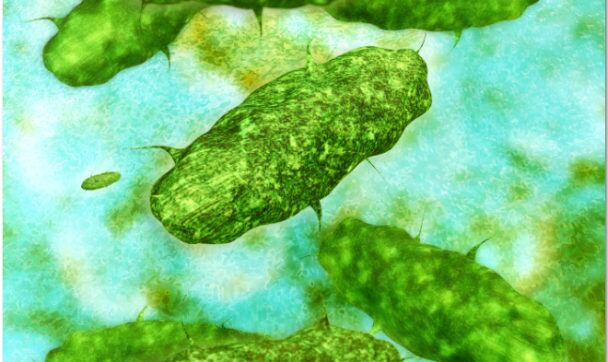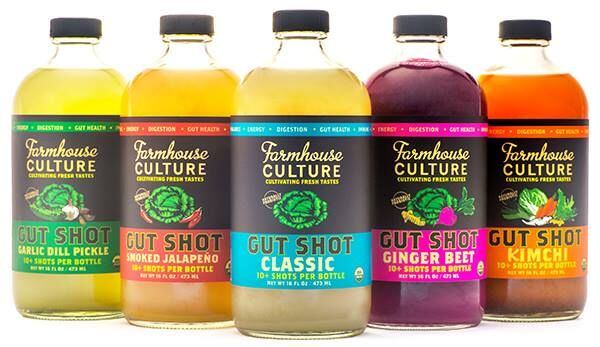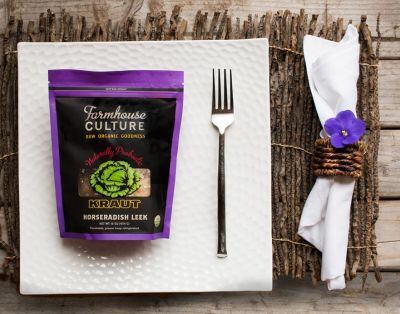While we have been eating fermented foods (beer, yogurt, sourdough bread) for years, products that are actively marketed as such (kimchi, kombucha, kefir) are still new to many Americans, said John Tucker, a food industry veteran who was most recently CEO of Dave’s Killer Bread (now owned by Flowers Foods).
However, they have huge potential as consumers seek bolder tasting, ‘ancient-yet-modern’ products associated with digestive health benefits, Tucker told FoodNavigator-USA.
“I’ve personally had a longstanding interest in probiotics and fermented foods, which is one reason I was really excited about the job at Farmhouse Cultures. The category is very new, so we’re really just seeing the tip of the iceberg, but retailers that see its high growth potential are paying a lot more attention now.”
Lactic acid fermentation
Founded by chef Kathryn Lukas in 2008, Farmhouse Culture is best known for its organic sauerkraut, which is fresh, refrigerated and non-pasteurized (whereas most sauerkraut sold in grocery stores is pasteurized and shelf-stable).
It is made by shredding cabbage and other veggies, adding salt, and packing them in barrels. After a period of time, the process of lacto-fermentation begins as the veggies start to pickle, creating complex and nuanced flavors, says Lukas, who argues that “Good kraut should be crunchy, slightly effervescent, and pleasingly sour.”
It is then packaged in Farmhouse Culture’s proprietary BPA-free pouches featuring ‘ferment-o-vents’ that allow the living microorganisms to breathe, and works as a standalone snack or as an addition to salads, dogs, sausages, sandwiches and numerous culinary dishes.
According to wild fermentation' guru Sandor Ellix Katz, fermentation can make food...
- More digestible: It can break down lactose and gluten to make them easier to digest, make minerals more bioavailable);
- More nutritious: It can increase B vitamin content and produce new metabolites and anti-carcinogenic compounds;
- More stable: eg. Sauerkraut has a longer shelf-life than fresh red cabbage;
- More tasty: From kombucha and soy sauce to pickled cabbage, fermentation creates strong flavors;
- More safe: Fermentation can preserve foods and break down some toxic compounds such as cyanide compounds, oxalic acid, phytic acid, and even residues of organophosphate chemicals used as pesticides and herbicides.

According to Dr Kayellen Umeakunne from the Morehouse School of Medicine, Atlanta, GA, a combination of changing diets and lifestyles, hospital births (more caesarians), less breastfeeding, antibiotic use, and our ‘war on germs’ has wreaked havoc with our gut bacteria.
To improve the ratio of good to bad bacteria in our guts, we should all be eating more fermented foods, probiotics (live ‘good’ bacteria) and prebiotics (stuff that the good bacteria can feed on - resistant starch, non-starch polysaccharides, dietary fiber, oligosaccharides), she says.
Raw kraut delivers a crisp, tooth-satisfying crunch
The fresh kraut contains vitamin C and probiotic Lactobacillus bacteria – which would typically be killed during pasteurization – and is safe to eat as long as it is refrigerated, says the company (it lasts for more than a year in the fridge).
Fresh kraut, which is also high in vitamin K, fiber, folate and a good source of zinc and other minerals, also has a superior taste and texture to cooked products, claims the firm: “Cooked kraut loses its snap and vibrancy when cooked… Raw kraut delivers a crisp, tooth-satisfying crunch that you’ll never you find in a can.”

Significant double digit growth
The kraut is available in stores including Whole Foods, Sprouts, The Fresh Market, Mariano’s and Costco, with a focus on the west coast, although Tucker is keen to expand distribution across the country:

“We’re seeing significant double digit growth – from great same store sales and growing distribution – but I think we can find placement in more conventional accounts as we’re having great dialog with key retailers that are impressed with our product and our brand.”
However, Farmhouse Culture’s new Gut Shot - which is made by fermenting veggies in barrels and harvesting the juices “once they’re brimming with active probiotics” - also has a lot of potential, if consumer interest in beverages with added probiotics (eg. GoodBelly) and kombucha (a fermented tea drink) is anything to go by, said Tucker.
“The Gut Shot [which can be added to salads, soups and stir fry, sipped as a shot or used in cocktails] is a recent introduction, but we’ve had enormous enthusiasm from retailers for it. We have a significant opportunity to expand the Farmhouse Culture brand into multiple categories.”
What are fermented foods?

According to 'wild fermentation' guru Sandor Ellix Katz, fermentation is integral to our culinary traditions: “All of the fermented foods and beverages we know are ancient and the people that pioneered them didn’t know anything about bacteria.”
But what is fermentation?
Says 'Katz: “The transformative action of micro-organisms and the enzymes they produce… Mostly this is a process of anaerobic digestion - where no oxygen is present - eg. yogurt, kefir, sauerkraut, kimchi, beer, wine, and bread. However, vinegar, kombucha, tempeh, molded cheeses, and other fermented foods do require oxygen.”
Examples of fermented foods: Kombucha (fermented tea), sauerkraut (fermented cabbage), natto (fermented soybeans), yogurt, cheese (fermented milk), beer, wine, sourdough bread, miso, soy sauce, and kefir.
